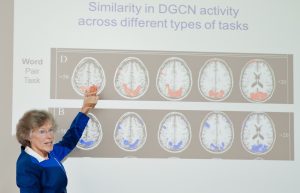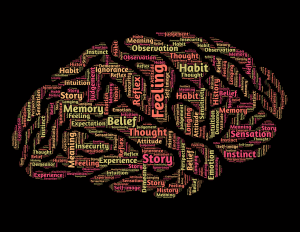By Kristi Kaeppel

For most of history, we educators have relied on our perception to gauge when students were actively learning in class. Over time–and after a few mishaps we’d all rather forget–we learn what works. We adapt, we discuss teaching issues with our colleagues, we add new strategies to our toolbox, and yes, we even occasionally walk away from a class with a sense that something clicked, the long-sought after a-ha moment happened.
And now here comes brain science, capable of validating–or contradicting–much of what we’ve learned over our years in the classroom. To explore some of the potential implications of neuroscience for college instruction, I interviewed Neag’s Dr. Sandy Bell, Associate Professor and Program Coordinator of the Adult Learning Program. In the following interview, she provides insights on how instructors can harness the brain’s self-regulation abilities and utilize emotions to increase student learning.
Note: Dr. Bell was suffering from laryngitis at the time of our interview, so she generously typed up her answers.
Kristi: What are some recent advances in neuroscience that shed light on learning? And how could this knowledge can be used in college instruction?
Sandy: First, great advances in imaging the brain over the past 5 year have enabled seeing the ways parts of the brain are all interconnected. Neuroimaging used to focus on specific parts of the brain, for example, Brocca’s language center, but now the focus is on the actual interconnections among parts of the brain. Sort of like focusing on destinations during a car trip, but now the focus is on the highways connecting all the destinations. These highways are interconnected sets of neural networks or connectomes. One network that has been identified is called the Domain General Cognitive Control Network. It is a network interconnecting parts of the brain that are active whenever anyone learns something new. It is active regardless of the nature of the new learning–it could be learning how to use a GPS app on a smartphone, or starting out learning a new language, or learning how to cross-country ski for the first time. I think there may be implications for supporting the learning of college students, both undergraduate and graduate, but I want to start with a caveat that these are suppositions based on my interpretations of studies in the neurosciences. I am not aware of empirical studies using functional imaging of the brain in authentic formal or informal adult learning contexts that support my ideas.
So having said that, I think it is valuable to appreciate the Domain General Network. What may be relevant to college instruction is that the parts of the brain that are active in early-stage learning are dedicated to focusing the learner’s attention, to serial processing of initial steps, and to enhancing formation of memories. All of that is not surprising, and I think most instructors introduce topics in ways that are consistent with these parts of the network. But there are other parts of the network dedicated to self-regulating one’s early learning experiences, specifically in setting goals, motivation, detecting errors, and making decisions, that I think many college instructors do not address in the early stages of learning. So often, instructors set all the initial learning goals, make decisions about what and how to learn something, and detect errors for students, rather than encouraging them to do these things themselves. The Domain General Network is all primed for these things, but instructors do not capitalize on it.
A third component of the network is dedicated to processing the emotional aspects of the learning, and to linking the new learning to one’s memory about one’s self, called the autobiographical memory. In simpler terms, these parts of the network are dedicated to enabling one to link the current learning to one’s prior experiences and to emotional aspects of those prior experiences. Students can have negative emotions associated with prior experiences that for some reason they see as associated with the new learning. Often this happens at a subconscious level and the student is not even sure why they feel so “turned off” to the learning. In my experience, many college instructors actively avoid any emotional aspects to learning, as if the emotional aspects of learning do not have a place in learning new content or skills. Yet, for many decades, researchers have documented the role of emotions in directing what we pay attention to and what we ignore, how we initially process or encode information, and how we recall and apply information later.
This brings me to another set of advances in the neurosciences that I think has direct relevance to college instruction. Over the past 10-15 years, cognitive neuroscientists have gained a much better understanding of ways different types of emotions impact different types of memories. Earlier research shows that negative core emotions, like fear, anger, and disgust, are really great at helping us to remember details of past experiences (called retrospective memory).
The trouble with negative core emotions is that sometimes an experience is so powerful that we remain focused on the details of the past—we relive them over and over again—and are at a loss at how to stop the cycle. Where recent advances have been made is in how positive core emotions, like joy and surprise, influence memory formation and how we use those memories. Positive emotions do not help create detailed memories for events the way negative core emotions do. Rather, memories of really positive events can be rather “fuzzy” on the details.
Whereas positive core emotions fall short in helping us remember details about the past, researchers have shown that they are great at helping us remember to do something in the future (called prospective memory). They are great motivators for future action and help us transfer knowledge and skills in new situations.
Studies have shown that positive core emotions relate to increasing effort and creative response in the face of challenges and generating multiple ideas to solve a problem. The real important finding is that a positive or negative emotion does not have to be related to the actual topic or skill being learned in order for it to influence learning. For example, one study showed that participants who watched a fun, upbeat movie prior to solving a problem scenario came up with an average of three times more ideas to solve it than participants who watched a movie evoked strong negative emotions. Another study showed that just changing the graphics in a self study multimedia program on immunology so that the images of viruses were given comical “sinister” faces and the antigens were given “smiley faces” resulted in higher scores on a test where participants needed to apply their knowledge about immunology.
I think the implications for facilitating student learning are twofold. First, instructors can recognize that students may enter a classroom in either positive or negative emotional states that can directly impact their learning and performance. Test anxiety is an example of a negative emotional state that can lead a student to ruminate on one or two bits of information yet keep them from thinking creatively in addressing problem scenario questions. On the other hand, just a smile and a hello can help evoke positive emotions that may enable students to be more engaged and put in more effort when they encounter challenges in the classroom. I have heard from students that some of their instructors never smile, and some seem to purposefully create a competitive atmosphere. I think if instructors were more aware of some of the research on the role of emotions on memory and learning, they would appreciate that their behaviors can evoke emotions in students in ways that can support or inhibit learning and performance and be more likely to break some of their habits that tend to evoke negative emotions. In terms of the brain, emotions are an integral part of learning. That’s the way the human brain is wired.
Kristi: How have you adapted your courses in light of the research on the brain and learning?
Sandy: I try to be attuned to the emotional states of students each time we meet for class. If I sense, or someone shares, that they are confused, or fearful, or even angry, I try to address it right away, particularly if the feeling is shared by many students. I do not believe that learning always has to be fun, but I do believe that it needs to feel emotionally and socially safe and respectful. And, that safety and respect provides the background for students to explore a range of emotions that can promote learning.
Research about the Domain General Cognitive Control Network has really influenced the importance I place on students’ developing effective knowledge and skills to self-regulate their own learning, particularly in the early stages of learning. I find that many students, both undergraduate and graduate, have never learned about self-regulation or had it be something that instructors expected them to be able to do. Because it is unfamiliar, sometimes students are resistant to taking more responsibility for their learning. I incorporate intentional and explicit activities to promote learning self-regulation in every one of my courses. In many courses, the activities culminate in students’ assigning their own final grades.
Kristi: What are some research areas that are on the horizon that could have an impact on teaching and learning?
Sandy: The technologies that enable scientists to see inside the brain while it is actually engaged in learning activities are getting better and better. Right now, most of the functional imaging occurs in experimental, controlled settings where individuals are relatively immobile. It looks like more portable imaging technologies will soon be available. I imagine one day in the not so distant future, we will be able to understand how the brain functions when individuals are engaged in real-life activities in real-life settings. When this occurs, we will be able to appreciate more nuanced individual differences and the mutual effect individuals and environments have on each other. I imagine that some day soon we will have a neuroscience explanation for some of the more well established learning theories, such as Bandura’s reciprocal determinism among person, environment, and behavior, or Kegan’s orders of consciousness and social maturity.
If you’re interested learning more about the brain and learning, Dr. Bell recommends the book Make It Stick by Peter Brown, Henry Roediger, and Mark McDaniel.